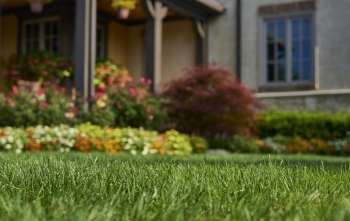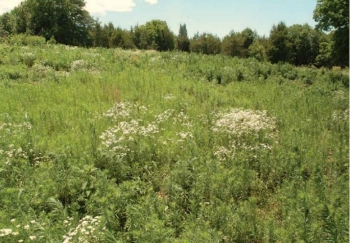Of Predators, Poults, and Pretty Lawns
By Roger Shields, Wild Turkey Program Coordinator
During the spring of 2020, thanks to Covid-19 and work from home policies, I had the opportunity to take many mid-day walks around the neighborhood with my wife. These daily outings were, for the most part, enjoyable times together, talking, reflecting, and getting some exercise. But they also led to a troublesome “honey-do” for me. See, my wife saw several neighbors who had beautiful, manicured lawns and decided she wanted a lovely lawn like that, too.
Her notion of improving our lawn seemed to me like it would involve a lot of unnecessary time, treasure and sweat (my time, treasure, and sweat). I tried to convince her that our weedy yard didn’t actually look that bad. After all, it was green (an improvement from the yard at our last home), and besides, it gave more foraging opportunities to the birds and critters in our neighborhood than a monotypic lawn of grass. This ploy was unsuccessful in deterring my wife and she was unrelenting. So, because I love my wife (and my peace and sanity), I agreed to tackle her request and her heart’s desire for a pretty lawn like the neighbors, the Jones’. This experience became far more of a learning experience than I had bargained for.
Soon after coming to my newfound determination to have a weed-free yard, we acquired some appropriate “weed killer” from our local home improvement store. But because of many other important and pressing activities in my life (I can’t recall now quite what any of them were), it was a few more weeks before I actually got around to applying the chemicals. Eventually, early one Saturday morning I got up, sprayed my yard, and then sat back to watch the chemicals do their work with eager anticipation. But nothing much happened. A few weeds showed a little of what I might call discomfort, but by and large, my efforts seemed to have no effect on the weeds. This is when I learned the first of many lessons in lawn care.
The first lesson I learned was that timing is important. Treating my yard before (or after) the weeds were actively growing was largely a wasted effort in terms of time and money. Weed treatments are most effective when applied at the time they will have the maximum effect on the target weeds, which is when the weeds are actively growing so they’ll take in and absorb the chemicals being applied.
The second disheartening lesson I made was that this was not a “one and done” proposition. Even after I finally killed off most of the weeds in my yard, more kept popping up thanks to seed dispersal from the weeds still present in my immediate neighbors’ yards. No matter how effective I was at removing the weeds from my yard, they kept blowing in from “across the fence.” So, to be truly weed-free, I have to treat my yard repeatedly every year.
My third lesson was that there are a lot of different types of weeds out there. Some chemicals treat broad-leafed weeds, while others treat unwanted grasses. But it’s really hard to kill every type of weed at the same time!
Lastly, I learned that I needed to have a good layer of grass before I applied the weed killer, otherwise I was left with just a barren, dirt landscape. A lawn care specialist explained to me that good, healthy grass actually helps prevent weeds from being able to take root and get established.
So, why am I sharing all of this? Am I trying to become a horticulturalist? No, not at all. But it dawned on me that the principles I learned from this experience apply equally well when discussing wild turkeys and improving the production of young turkeys (aka poults). With many people concerned about declining turkey numbers, we hear all the time how crucial controlling the number of predators is for successful reproduction, especially knowing that over half of all nests and poults are lost to predation. It only makes sense that reducing the number of predators will help produce more poults, right? The problem is predators are in some ways a lot like weeds. Predator management may be helpful at a local scale, but it isn’t as simple as it may sound.
First, timing of control is important. It must be done immediately before nesting season. Just like treating my weeds at the wrong time didn’t produce the intended results, controlling predator numbers needs to be at the right time, too, or you won’t produce the results you want—more successful nests and broods.
Second, understand that predator management, like weed management, is not a “one and done” proposition. Even if you could remove every predator on your property, it doesn’t take long for ones from your neighbor’s property to find their way to yours. This is the main reason why the timing is so important. Because it only takes a few weeks (or even days) for more predators to find their way back on to your land, if you do your management too far in front of nesting season, you’ve essentially had no effect. And just because you’ve removed some predators this year, doesn’t mean it will have much effect the following year unless you do it again.
Third, just as there are many, many types of weeds, there are many types of predators, only some of which can reasonably be controlled. While raccoons, skunks, opossums, and other small mammals can often be successfully trapped, no effective means are available to control snakes; and avian predators like crows, hawks, and owls are federally protected. So, if you’re interested in trapping furbearers to help turkeys be more successful, keep in mind that you’re at best only impacting a portion of the predators on the landscape.
Lastly, and perhaps most overlooked, is the impact that a healthy habitat has on nesting success and poult survival. Let us not forget that wild turkeys have been dealing with predators for a lot longer than we have and they’ve somehow managed to survive and thrive. That’s because turkeys have evolved to be able to deal with predators and relatively high losses, if they have the habitat that balances the playing field. Just as a healthy lawn helps prevent weeds from becoming established in the first place, good turkey habitat helps turkeys avoid predators so they can nest and rear their young successfully. The best habitat balances forests and openings, where the openings have areas of thicker, knee-high grasses and shrubs for nesting intermixed with areas of more open herbaceous structure (i.e., clean at ground level with a low umbrella of native flowers and grasses) for brooding. And it doesn’t take much effort at times to make a difference. Even simply delaying bush-hogging until later in the summer can produce favorable results. So, while you’re working to control predators, don’t forget it’s just as important (if not more important) to manage the habitat for good nesting and brooding cover.
We all like pretty, weed-free lawns and seeing lots of wild turkeys, but as you consider management to achieve these ends, be realistic about your expectations and smart in the way you use your individual time, treasure, and sweat equity. And please remember the importance of good habitat to the successful production of wild turkeys. To that end, TWRA private lands biologists stand ready to offer guidance and management advice if you are interested in doing more for wild turkeys on your property.

